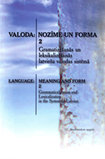Gramatizēšanās un desemantizēšanās attieksmes
Relationship of Grammaticalization and Desemantization
Author(s): Ilze LokmaneSubject(s): Language and Literature Studies, Theoretical Linguistics, Semantics, Baltic Languages
Published by: Latvijas Universitātes Akadēmiskais apgāds
Keywords: desemantizēšanās ; gramatiskā nozīme ; metafora ; metonīmija ; reanalīze;
Summary/Abstract: The article deals with semantic changes involved in the process of grammaticalization: desemantization or loss of initial semantic elements, emergence of new semantic elements. The initial and final stages of grammaticalization may have no common semantic elements at all, in other cases semantics of linguistic unit remains partly unchanged. Change of semantic structure in the process of grammaticalization may also be interpreted as metaphorical or metonymical shift.In order to assume that a linguistic unit has been grammaticalized, one has to prove that it has lost the initial lexical meaning and gained a new – grammatical one. The article touches upon the most important features of grammatical meanings – they are general, synsemantic, collective, obligatory and regular.The most complicated instances of grammaticalization are those where no formal changes occur, e. g., when lexical verbs become copular verbs or modal modifiers. In order to distinguish lexical verbs from grammaticalized ones the following methods can be used besides semantic analysis: replacement, which involves the principle of analogy of syntactic postion, transformation of simple sentence into composite sentence, as well as distributional analysis.
Journal: Valoda: nozīme un forma
- Issue Year: 2012
- Issue No: 2
- Page Range: 10-16
- Page Count: 7
- Language: Latvian

